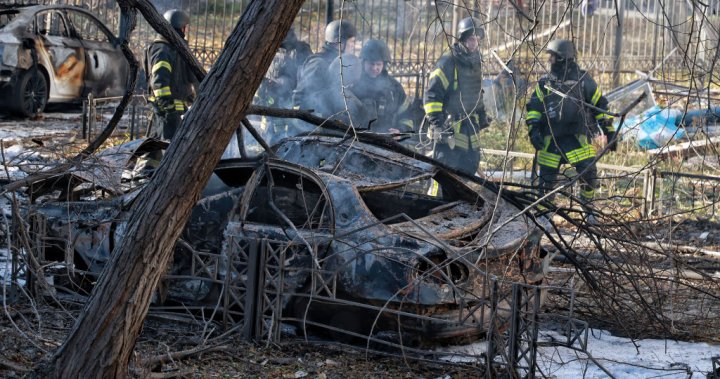I arrived in Odesa three days after the Russian drone slammed into the city center. The acrid smell of burned timber still hung in the morning air as local emergency workers sorted through the rubble of what was once a nine-story apartment building. Among them was Vasyl, a 62-year-old retired engineer who lost his neighbor in the attack.
“We heard the air raid siren, but many didn’t go to shelters anymore. After two years, you become numb to the warnings,” he told me, his hands black with soot from helping clear debris. “Oksana was cooking dinner for her grandchildren when it happened.”
The Saturday strike killed two people and wounded 17 others in the strategic Black Sea port city, the latest in Moscow’s punishing aerial campaign that has increasingly targeted civilian infrastructure as the war grinds toward its third year.
Ukrainian officials confirmed the attack used an Iranian-designed Shahed drone – part of Russia’s expanding arsenal of cheaper, more accessible weapons that have become the workhorses of its campaign against Ukrainian cities. According to Ukraine’s air force, Russian forces launched 69 drones overnight, with 58 successfully intercepted across multiple regions.
Meanwhile, Ukraine has stepped up its own long-range strikes on Russian territory. Military sources in Kyiv claimed their forces destroyed two Russian Ka-52 attack helicopters and damaged another at an airfield in Russian-occupied Crimea the same day as the Odesa attack. The Ukrainian military’s Strategic Communications Directorate released satellite imagery showing what appeared to be damaged aircraft at Belbek airfield near Sevastopol.
“This is our response to their terror against our civilians,” said Colonel Yuriy Kovalenko, a Ukrainian military spokesperson I met at a heavily fortified command post outside Odesa. “The difference is we target their military assets, not residential buildings.”
Both sides are escalating aerial operations as the front lines remain largely static. I spent the previous week visiting Ukrainian positions along the southeastern front, where soldiers described a brutal war of attrition with incremental territorial changes measured in meters rather than kilometers.
The Odesa strike fits into a broader pattern of Russia’s evolving air campaign. Data from the Ukrainian emergency services shows civilian casualties from aerial attacks have increased 28% in the last three months compared to the previous quarter, with over 70% of fatalities occurring in residential areas.
“Russia’s strategic calculus appears to be shifting toward breaking Ukrainian resilience through sustained civilian targeting,” explained Dr. Olena Tregub, secretary-general of the Independent Defense Anti-Corruption Committee in Kyiv, who shared her analysis with me over a secure call. “With limited advances on the battlefield, the Kremlin is banking on societal exhaustion.”
The human cost of this strategy was evident in Odesa’s hospital corridors. At the regional medical center, surgeon Dr. Iryna Vovk hadn’t slept in 36 hours when I met her between emergency operations.
“The injuries we’re seeing from these drone strikes are particularly severe – complex fragment wounds, blast injuries, burns,” she explained, showing me X-rays of a 12-year-old boy with metal fragments lodged near his spine. “We’re running low on specialized trauma equipment and pain management medications.”
Ukraine’s ability to counter such attacks has been hampered by delays in Western military aid. A senior Ukrainian defense official, speaking on condition of anonymity because they weren’t authorized to discuss sensitive matters publicly, told me air defense coverage for Odesa region stands at approximately 60% of required capacity.
“The mathematics is simple – without additional systems, more civilians will die,” the official said.
On Russia’s side, the increase in drone usage represents an industrial solution to a protracted conflict. Western intelligence estimates suggest Russia is now producing over 1,000 attack drones monthly with components sourced from China, Iran, and other partners willing to circumvent sanctions.
“They’ve essentially created a wartime economy for drone production,” said Michael Kofman, a senior fellow at the Carnegie Endowment for International Peace, when I reached him by phone. “The shift to lower-cost, mass-produced weapons allows them to sustain this aerial campaign indefinitely.”
For Odesa residents, this new reality has transformed daily life. At a partially destroyed school near the strike site, I found teacher Svitlana Horova salvaging books from her classroom. The building’s eastern wall had been blown open, exposing desks and chairs to the elements.
“We’ve converted our basement into a shelter and classroom combined,” she explained. “The children know exactly what to do when the sirens sound. They can transition from math lessons to safety protocols in under two minutes.”
The psychological toll extends beyond the immediate victims. At a local community center serving as a temporary shelter, psychologist Maryna Petrenko described treating increasing cases of severe anxiety and PTSD among residents.
“Many survivors experience profound guilt – why was it their neighbor instead of them? Children draw pictures of drones instead of sunshine,” she said, showing me artwork created by her young patients. “This is the invisible damage that statistics don’t capture.”
Ukrainian President Volodymyr Zelenskyy addressed the Odesa attack during a Sunday video address, reiterating calls for allies to permit longer-range strikes with Western weapons and accelerate delivery of promised air defense systems.
“Every week we lose innocent lives waiting for decisions already made on paper,” he said.
As I prepared to leave Odesa for my next assignment, emergency workers discovered another body in the rubble – bringing the death toll to three. Local officials expect this number may rise as the search continues.
Back at my hotel overlooking the once-bustling port, the air raid siren wailed again. In the distance, the distinctive drone of another Shahed engine grew louder over the Black Sea. Anti-aircraft guns opened fire, tracing orange lines across the twilight sky.
This is the rhythm of life in modern Ukraine – moments of normality punctuated by deadly reminders that nowhere is truly safe. For the people of Odesa, tomorrow brings another day of resilience under fire, as the war’s deadly aerial dimension continues to evolve far above their heads.






